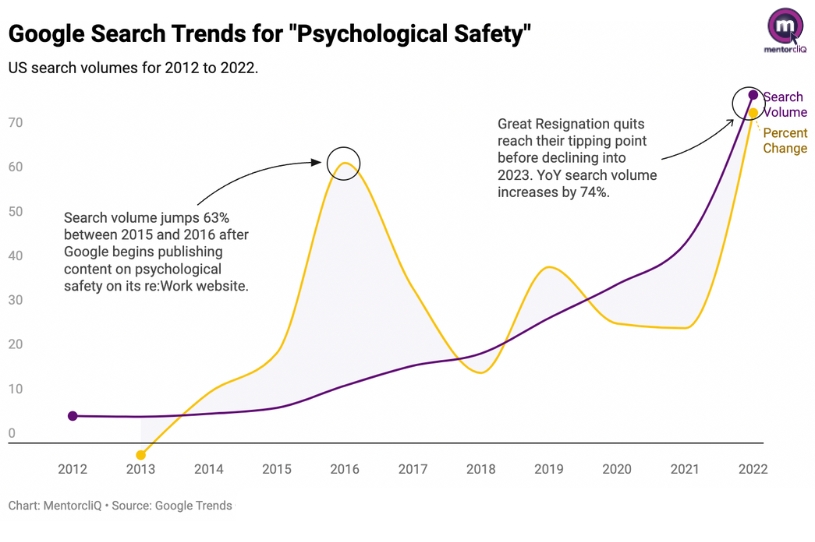In 2015, Google launched its re:Work website, designed to help companies improve their approach to employee engagement and management. From 2015 to 2018, Google published content on a variety of topics, including psychological safety in the workplace. At the time, the concept of psychological safety was largely unknown outside of academic research papers. But, thanks in no small part to Google’s overwhelming presence, the term began trending around 2016 and interest hasn’t slowed since.
Gen Z and Millennial workers are quickly overtaking Boomer and Gen X workers at companies in the US and abroad. These generations strongly value psychological safety in the workplace. HR leaders who want to make sure they hire and retain the best talent need to be firmly grounded in what psychological safety means and how to effectively apply it.
What Is Psychological Safety in the Workplace?
A psychologically safe workplace is one where employees and team members feel confident to openly share their opinions, thoughts, and ideas without fearing retaliation or humiliation. This includes voicing suggestions or concerns about various workplace matters.
In a psychologically safe work environment, a shared understanding encourages collaboration, feedback, risk-taking, and the free exchange of ideas. This doesn’t necessarily mean everyone must always be nice or friendly to one another. Instead, it’s about fostering an atmosphere where differences can be openly discussed and acknowledged, understanding that agreement isn’t always possible or necessary.
Why is psychological safety trending right now?
There are multiple factors influencing the trend toward supporting psychological safety at work:
- A growing acceptance of mental health as a legitimate concern, especially among Millennial and Gen Z workers
- Increasing number of Gen Z workers entering the workforce
- Increasing number of Millennials getting promoted to management and decision-making roles within HR
- A dynamic prioritization shift following the pandemic.
That latter point is especially evidenced by Google Search Trends. Search volumes for “psychological safety” were mostly stagnant until 2016, when Google’s advocacy for it began shifting interests. From there, search trends accelerated, but with the most significant spike in year-over-year volume increase happening in 2022 — the year Great Resignation quits reached their highest point.

Note that the large increase in search interest from psychological safety is not coming from workers as much as it is from HR leaders seeking to better understand the term.
As Amy C. Edmondson and Derrick P. Bransby explained in their research paper, Psychological Safety Comes of Age: Observed Themes in an Established Literature, more than half of the studies published on the term in HR and organizational development journals were published between 2019 and 2021. Likely, that’s due to increasing demand in interest from HR leaders seeking to better understand how psychological safety at work impacts key employee metrics, including retention and productivity.
An Ecsell Institute report reveals that companies prioritizing psychological safety see their teams generating an impressive $4.3 million per year. Such data underscores the significant impact of psychological safety on performance and its role in reducing employee turnover. Accenture further supports this, suggesting that psychological safety in the workplace can amplify team performance by as much as fivefold.
At its core, creating psychological safety is about allowing room for individual growth and cooperative endeavors. It paves the way for everyone to display their true potential without being held back by fear or concern.
What are the key elements of a psychologically safe workplace? To foster high-performing teams, these components are essential:
- Inclusion: This is achieved when employees feel recognized, accepted, and valued for who they are and what they offer to the organization.
- Learning: This environment is fostered when employees are encouraged to ask questions, experiment with new methods, explore novel ideas, and make mistakes without fear of retribution.
- Contribution: Employees should feel that their efforts make a significant impact and that their contributions are acknowledged and appreciated, free from shame or ridicule.
- Challenge: A psychologically safe workplace supports employees in questioning the status quo. Their drive for growth and innovation should be not only accepted but actively encouraged.
And it’s not just a matter of having these elements. Companies need to make sure these are structured and intentional.
Psychological Safety vs Psychological Health vs Neurodivergence
I previously wrote about the importance of supporting neurodiversity in the workplace. That’s a related topic, but companies shouldn’t conflate this with psychological safety and psychological health. All three are separate issues.

Neurodivergence: This term refers to variations in brain functions that can impact how workers engage with their team and role. It covers areas such as ADHD, autism, and dyslexia. In a work setting, it emphasizes the need for tailored approaches to psychological safety and mental health that account for these physiological differences. Both leaders and team members should be proactive in understanding and accommodating the unique needs and strengths of neurodivergent individuals within the framework of psychological safety and psychological health..
Psychological safety: This concept pertains specifically to the team and work environment. It hinges on a collective effort involving everyone. Each person plays a role in nurturing an environment where everyone can thrive, feel valued, and be engaged. Psychological safety focuses on ensuring that team members can voice their ideas, concerns, and feelings without fear of negative repercussions.
Psychological health (mental health): This concept pertains to an individual’s mental and emotional well-being. Various personal and professional factors can influence someone’s psychological health. While a psychologically safe work environment can positively impact an individual’s mental health, it’s just one of many potential influences.
Why Is Psychological Safety Important at Work?
Psychological safety in the workplace has transitioned from being a “nice-to-have” to an essential component for a productive and harmonious work environment. Here are the compelling reasons, backed by an expanding body of research, which highlight its importance:
- Enhanced employee engagement: Psychologically safe environments motivate employees to fully engage and present in their roles.
- Inclusive Culture: It fosters an inclusive workplace culture that values and embraces diversity.
- Innovation and idea exchange: Employees feel empowered to share and exchange novel ideas, leading to innovation.
- Employee well-being: A psychologically safe environment promotes overall well-being and mental health.
- Brand ambassadors: Employees in such environments are likelier to become positive ambassadors for the organization.
- Retention and talent acquisition: Psychological safety boosts employee retention rates and attracts top talent.
- Improved performance: Teams work more effectively, and individuals have room to grow, leading to enhanced overall performance.
Additionally, psychological safety in the workplace is squarely a diversity, equity, and inclusion concern. And according to an Eagle Hill report, over 50% of workers now say a company’s DEI approach is a major factor when they consider taking a job offer. Within reason, that also impacts employee retention.
Signs Your Workplace Is Psychologically Unsafe
Too often, leaders might not recognize that their work environment is toxic and does not allow people to speak openly or feel comfortable sharing new ideas or taking risks. Effective leaders know when to adjust their leadership style to best suit the environment, but psychological safety should be something every leader strives to provide for their teams.
These are all the answers and tell-tale signs you should look for regarding psychological safety in the workplace.
Managers or leaders micro-manage every aspect of the work
Leaders who promote psychological safety are those who encourage their employees to work in a style that improves their overall performance. Not everyone works the same way. Hence, imposing a particular way of working is unhealthy and does not make workers feel safe, especially in diverse teams.
When forced to work using a particular method, it leaves little room for people to showcase their true potential and can demotivate teams. The performance of individual contributors, teams, and the whole organization can suffer.
Employees or team members are fearful of changing the status quo
A good sign of a psychologically safe workplace is where team members can freely ask questions or share new ideas without fear of reprimanding. In fact, challenging the status quo and asking questions is encouraged in psychologically safe work environments. It is a sign that employees feel comfortable and open enough to raise concerns.
On the other hand, a lack of psychological safety makes people wary about speaking up because they could be “punished’ for doing so. Psychological safety is low when employees would rather keep their concerns to themselves instead of letting their fellow employees or leaders be aware of such concerns.
High absenteeism and employee turnover rate
Employees feel unmotivated to go to work when they have a workplace lacking psychological safety. As a result, it’s about time more employee calls for unplanned leaves and absences.
Most absences result from employees wanting to escape from the highly toxic work environment or intense job pressure. They call in sick even when they’re not physically ill. And it’s no secret that high absenteeism can negatively impact your team’s overall productivity.
Meanwhile, employees who feel psychologically safe are more likely to stay in their current employment. Companies should look at ways to ensure psychological safety in order to improve employee retention rates. Reducing employee turnover should be a priority if you want to keep top talents within your team.
Leaders don’t give recognition to employees
Employee recognition is a vital aspect of a productive and psychologically safe workplace. It is also linked to higher employee engagement.
Do the leaders in your organization give credit when it’s due?
Even a simple “good job” or recognition email to show your appreciation for a job well done is enough to make employees feel valued and recognized. Employee recognition is a major source of encouragement, which motivates team members to give their best at work. Bonuses and other incentives are a nifty touch, but showing appreciation is what it’s really about.
On the other hand, failure to foster psychological safety in the workplace can result in high levels of workplace stress and loss of motivation. These can have negative consequences, such as lower productivity among employees.
Employees are kept in the dark about crucial information
When employees are kept in the dark, it also builds mistrust between employees and management. It creates a series of negative consequences, including low team morale and employees not reaching out for help (even when they really need it).
The return-to-office trend is a perfect example of the consequences of leaving employees in the dark about decisions. After making bold statements about supporting remote work forever, many companies gave employees whiplash in the past year by suddenly backtracking and demanding a return to office. This has caused significant distress for employees and has seen some companies lose half of their employees almost overnight.
An organization that values psychological safety seeks input from team members when making crucial and strategic business decisions, especially ones that directly impact them— like RTO. When these decisions are made without consulting employees, they feel insecure about their job and their input unvalued. It also shows a lack of consideration from top management about the possible effects of those crucial decisions on the employees and the organization in general.
8 Ways to Build Psychological Safety at Work
Creating a work environment that prioritizes psychological safety is not a one-and-done task; it’s an ongoing commitment. From leadership to entry-level positions, everyone plays a crucial role in shaping a culture where employees feel safe, respected, and valued.
The following strategies offer a roadmap for organizations looking to foster a culture of psychological safety. By implementing these practices, you can pave the way for increased employee engagement, higher job satisfaction, and a more innovative and collaborative workplace.
1. Embed psychological safety in company culture
A company’s culture is the lifeblood of its operations. It permeates every aspect, from decision-making to daily interactions.
Instilling psychological safety into this culture sends a clear message about the company’s values and priorities. This isn’t about ignoring employees’ mistakes. It’s about understanding nuance and appropriate reactions.
Fostering an environment where employees feel free to voice concerns, try out new ideas, and learn from experiences builds trust and encourages creativity. A psychologically safe work climate becomes a nurturing space where employees can thrive, push boundaries, and contribute meaningfully. Such a culture becomes self-perpetuating, with employees passing on these values to new hires enrolled in your onboarding mentoring programs.
2. Encourage open communication
Communication isn’t just encouraged in a psychologically safe workspace — it’s essential. When employees know they can express concerns, share ideas, or ask questions without fear of reprisal, it breaks down barriers. It fosters a collaborative environment where people aren’t just working for a paycheck but are genuinely invested.
In this environment, employees are likely to increase the amount they communicate to each other. It’s why Accenture notes that companies with a high degree of psychological safety see 76% more employee engagement and their workers are 57% more likely to collaborate.
Employees who feel safe to share become proactive, thinking about ways to improve processes, address challenges, and innovate. This open culture also shows employees that their voices and contributions matter.
3. Prioritize transparency
We’d like to imagine the days of executives making top-level decisions behind closed doors are long gone. The return-to-office trend of 2023 has taught us better as employees are now engaging in what’s called The Great Resistance. Many companies still make decisions without employee inputy, expecting employees to follow without question.
Yet modern workplaces thrive on transparency. Companies can mitigate resistance and apprehension by including employees in decision-making processes, especially those directly affecting them.
Informed employees are empowered employees. Knowing the ‘why’ behind decisions, understanding company direction, and being part of the change process can transform the work environment, fostering trust and commitment.
4. Establish norms for mistakes
As the saying goes, “to err is human, to forgive is divine.”
But in a high-pressure work environment, mistakes can be costly. Forgiveness can be difficult when an employee’s mistakes result in a financial hit or incalculable reputation damage.
However, in a psychologically safe space, mistakes become stepping stones for learning. Instead of punitive measures, the focus should shift to understanding what went wrong, how to rectify it, and how to prevent it in the future. This proactive approach resolves issues faster and encourages employees to take calculated risks, innovate, and venture outside their comfort zones.
5. Champion fairness
The modern workspace is a diverse environment. Fairness becomes paramount with employees from various backgrounds, cultures, and beliefs. Every employee, be it in-office or remote, should have equal access to opportunities, resources, and career-impacting mentoring relationships.
Regular surveys, feedback mechanisms, and open forums can help management identify and rectify any biases or prejudices, ensuring a level playing field for all.
6. Manage conflicts effectively
Where there are people, there will be disagreements. Instead of brushing conflicts under the rug, address them head-on.
Promote a culture where differences are discussed, not suppressed. Encourage dialogue, foster mutual respect, and ensure everyone is heard. Such an environment resolves issues amicably and brings about creative solutions and compromises that cater to a broader range of needs and preferences.
7. Focus on employee well-being
The importance of well-being, especially mental health, cannot be overstated. Stress, anxiety, and burnout are genuine concerns, impacting not just work but employees’ personal lives.
By prioritizing well-being, companies don’t just improve productivity; they send a clear message that they care. Flexible schedules, access to counseling, regular check-ins, and wellness programs can drastically improve morale and overall employee satisfaction.
8. Introduce mentorship programs
Mentorship isn’t just about training — it’s about guiding, building confidence, fostering growth, building employee networks, and creating community at work. Having someone to advise, direct, and support, especially in the early stages of one’s career, can make all the difference.
Mentorship programs underline a company’s commitment to its employees, emphasizing continuous learning and development. Such initiatives also foster deeper relationships within teams, creating cohesive units working towards shared goals.
Try this on for size: Mentoring programs work best when bias is removed from the matching process. Check out our software to learn how automated matching produces higher-quality relationships and an average 50% reduction in employee turnover among participants.
Creating a Workplace Where Everyone Feels Psychologically Safe
A safe environment isn’t just about physical well-being. Safety extends to how comfortable employees feel being themselves, making mistakes, and expressing creative thoughts and ideas.
When employees thrive when they are valued, heard, and respected. It’s a space where innovation flourishes and collaboration becomes second nature. It’s where risks are taken, not out of recklessness but from a place of trust and support. When employees know they can make mistakes without punitive consequences, they’re more likely to think outside the box, leading to breakthrough solutions.
But creating such an environment requires more than just good intentions. It demands consistent effort, open communication, and a commitment to uphold these values at every level of the organization. As industries evolve, competition intensifies, and the demands of the job market shift, only those organizations that prioritize their teams’ mental and emotional well-being will thrive.
After all, at the heart of every successful company are its people; when they feel safe, they can and will do incredible things.




